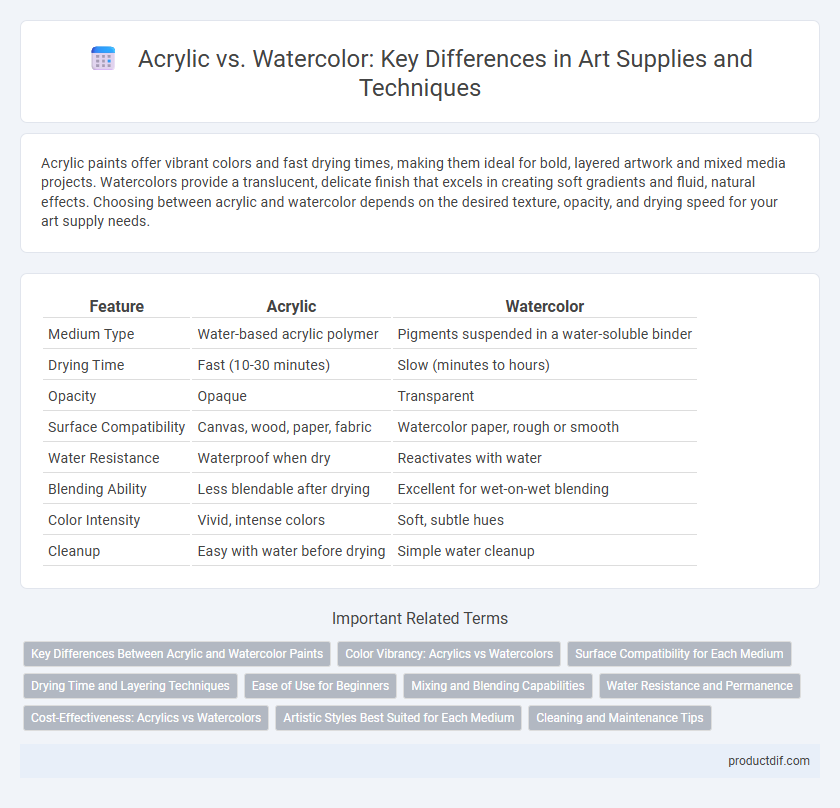Acrylic paints offer vibrant colors and fast drying times, making them ideal for bold, layered artwork and mixed media projects. Watercolors provide a translucent, delicate finish that excels in creating soft gradients and fluid, natural effects. Choosing between acrylic and watercolor depends on the desired texture, opacity, and drying speed for your art supply needs.
Table of Comparison
| Feature | Acrylic | Watercolor |
|---|---|---|
| Medium Type | Water-based acrylic polymer | Pigments suspended in a water-soluble binder |
| Drying Time | Fast (10-30 minutes) | Slow (minutes to hours) |
| Opacity | Opaque | Transparent |
| Surface Compatibility | Canvas, wood, paper, fabric | Watercolor paper, rough or smooth |
| Water Resistance | Waterproof when dry | Reactivates with water |
| Blending Ability | Less blendable after drying | Excellent for wet-on-wet blending |
| Color Intensity | Vivid, intense colors | Soft, subtle hues |
| Cleanup | Easy with water before drying | Simple water cleanup |
Key Differences Between Acrylic and Watercolor Paints
Acrylic paints dry quickly and create vibrant, opaque layers, making them ideal for bold, textured artwork, while watercolor paints dry faster but remain translucent, allowing artists to build delicate, luminous washes. Acrylics are water-resistant once dry and flexible for mixed media techniques, whereas watercolors rehydrate easily and require specific paper for optimal absorbency. The chemical composition differs as acrylics are synthetic polymers, and watercolors are pigment suspended in a water-soluble binder, influencing texture, layering, and finish in artworks.
Color Vibrancy: Acrylics vs Watercolors
Acrylic paints deliver intense, vibrant colors due to their high pigment concentration and quick-drying properties, making them ideal for artists seeking bold, lasting hues. Watercolors offer a translucent, delicate vibrancy that changes with water dilution, providing luminous effects and subtle color blending. The choice between acrylics and watercolors ultimately depends on the desired color intensity and texture in the artwork.
Surface Compatibility for Each Medium
Acrylic paints are highly versatile and compatible with a wide range of surfaces including canvas, wood, paper, and fabric, providing strong adhesion and durability. Watercolors perform best on specialized watercolor paper designed to absorb and hold pigment without warping or bleeding. The choice between acrylic and watercolor often depends on the texture and absorbency of the surface to achieve optimal color vibrancy and longevity.
Drying Time and Layering Techniques
Acrylic paint dries rapidly, typically within 15 to 30 minutes, allowing artists to apply multiple layers quickly without waiting long periods. Watercolor has a slower drying time, ranging from several minutes to over an hour depending on humidity and paper type, which influences blending and washes. Layering techniques differ significantly: acrylics enable opaque overpainting and texture buildup, while watercolors rely on transparent glazing and controlled water flow for subtle color transitions.
Ease of Use for Beginners
Acrylic paints dry quickly and are less prone to smudging, making them easier for beginners to control compared to watercolors. Watercolors require a more precise balance of water and pigment, which can be challenging for novice artists to master. Acrylics offer more forgiveness during layering and corrections, enhancing their ease of use for those new to painting.
Mixing and Blending Capabilities
Acrylic paints offer superior mixing and blending capabilities due to their quick drying time and thick consistency, allowing artists to create smooth gradients and rich textures. Watercolors, while more transparent and delicate, blend seamlessly with water, enabling subtle washes and soft transitions but require careful control to avoid muddy colors. Both mediums provide unique advantages, with acrylics excelling in vibrant layering and watercolors favored for their fluid, translucent effects.
Water Resistance and Permanence
Acrylic paints offer superior water resistance and permanence compared to watercolors, as they dry to a durable, waterproof finish that resists fading and smudging over time. Watercolors are more susceptible to reactivation with water, making them less permanent and ideal for delicate, translucent effects but requiring careful handling to preserve the artwork. Artists seeking long-lasting, water-resistant results typically prefer acrylics for projects exposed to moisture or outdoor conditions.
Cost-Effectiveness: Acrylics vs Watercolors
Acrylic paints generally offer greater cost-effectiveness due to their higher pigment concentration, which allows for better coverage and longer usage per tube compared to watercolors. Watercolors typically require more layers and paper quality adjustments, increasing supply expenses over time. Artists seeking budget-friendly options often find acrylics a more economical choice for vibrant, durable artwork.
Artistic Styles Best Suited for Each Medium
Acrylic paints are ideal for bold, vibrant styles such as abstract, modern, and mixed media art due to their fast drying time and versatility in texture. Watercolors excel in delicate, translucent effects suited for landscapes, botanical illustrations, and ethereal, impressionistic works because of their fluidity and light-reflecting properties. Artists often choose acrylics for layering and textural experimentation, while watercolors are preferred for soft washes and subtle color gradients.
Cleaning and Maintenance Tips
Acrylic paints require quick cleaning with water while still wet to prevent permanent residue, using mild soap and warm water for brushes after each session. Watercolor tools are easier to maintain, often cleaned with just water, but dry pigments can be gently removed with a soft cloth to avoid damage. Proper storage and regular brush conditioning extend the lifespan of both acrylic and watercolor materials, ensuring optimal performance for future projects.
Acrylic vs Watercolor Infographic

 productdif.com
productdif.com